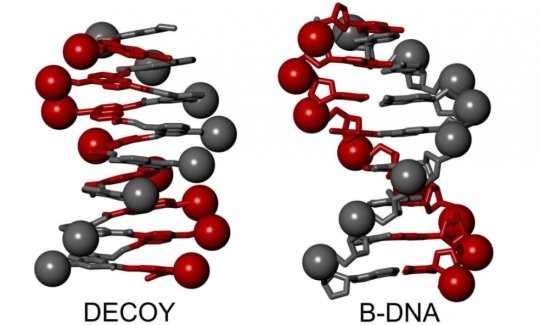Decoy molecules represent potential cure for HIV
Biomimetic chemistry, a laboratory procedure designed to imitate a natural chemical process, has taken a big leap thanks to chemist Ivan Huc. He has shown that it’s possible to mimic molecules so closely that DNA-binding proteins are actually interacting with them.
Specifically, he is creating ‘unnatural’ molecules which can be bent and folded to adopt specific shapes and are very similar to biological polymers, proteins, and DNA.
Huc is the head of a group of scientists who are committed to supramolecular chemistry. Their latest study shows that synthetic compounds are able to inhibit DNA-processing enzymes; notably, this includes the ‘integrase’ used by Human Immunodeficiency Virus (HIV) to infiltrate host cells and insert its genome.
In other words, it’s possible that Huc and his team have found the roots of a method to defeat HIV and AIDS.

There have already been two studies released by Huc and his team, the first illustrated how they developed a pattern of binding interactions to enable synthetic molecules assume stable shapes similar to helical backbones of proteins. The second study worked out the conditions necessary for the synthetic helix to be appended to natural proteins.
HIV integrase bind to the decoy and then are essentially deactivated.
In this third study, the team introduced a synthetic foldable molecule, which can transform itself into a helical structure mimicking the surface features of the DNA double helix, and which can be modified modularly by attaching substituents. The mime works so well that it can act as a decoy for DNA-binding enzymes. In the case of HIV, HIV integrase bind to the decoy and then are essentially deactivated.
If HIV continues binding to natural molecules in addition to the decoy, we still have a problem. Huc says, “If the enzymes still bind to the foldamer under competitive conditions, then the mimic must be a better binder than the natural DNA itself…” And, indeed HIV integrase are more readily binding to the decoy than to the natural DNA.
Hugely promising applications lie in wait for Huc’s research to become mature enough to be used in real world applications. Thanks to the transformable nature of the synthetic “foldamers” it will be relatively simple to adjust the science to different genetic applications.
https://gizbeat.com/12684/decoy-molecules-represent-potential-cure-for-hiv/https://gizbeat.com/wp-content/uploads/180402110736_1_540x360-450x271.jpghttps://gizbeat.com/wp-content/uploads/180402110736_1_540x360-150x150.jpgScienceTechBiomimetic chemistry, a laboratory procedure designed to imitate a natural chemical process, has taken a big leap thanks to chemist Ivan Huc. He has shown that it's possible to mimic molecules so closely that DNA-binding proteins are actually interacting with them. Specifically, he is creating 'unnatural' molecules which can be bent and...Damian Parsonshttps://plus.google.com/107879368390224447304 [email protected]AdministratorHi, I'm Damian Parsons. I've been working with Android phones since the first Droid came out. I'm fascinated by computers and technology. My first BBS were ran on an old Apple IIc and Commodore 64. I work hard to bring the latest updates to you every day - without all the boring fluff. Please subscribe to keep up on the newest China tech. See our forum -> www.chinaphonearena.comGizBeat





There already is a cure for HIV, as there is for all Cancers and other “diseases”. It is the Lymphatic system in the human body (otherwise known as the immune system!) If given the right tools (and I don’t mean pharmaceuticals, I mean education) then the body can heal itself. It makes me so upset to see that billions of *** enter currency of choice here*** are wasted yearly. Good health is freely available to everyone on this planet. It is unfortunately the individual’s choice as to whether to take on the mantle and “wear the robe”. People give up having been told by the medical community that “there’s nothing we can do”